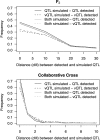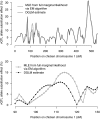Detecting major genetic loci controlling phenotypic variability in experimental crosses
- PMID: 21467569
- PMCID: PMC3122324
- DOI: 10.1534/genetics.111.127068
Detecting major genetic loci controlling phenotypic variability in experimental crosses
Abstract
Traditional methods for detecting genes that affect complex diseases in humans or animal models, milk production in livestock, or other traits of interest, have asked whether variation in genotype produces a change in that trait's average value. But focusing on differences in the mean ignores differences in variability about that mean. The robustness, or uniformity, of an individual's character is not only of great practical importance in medical genetics and food production but is also of scientific and evolutionary interest (e.g., blood pressure in animal models of heart disease, litter size in pigs, flowering time in plants). We describe a method for detecting major genes controlling the phenotypic variance, referring to these as vQTL. Our method uses a double generalized linear model with linear predictors based on probabilities of line origin. We evaluate our method on simulated F₂ and collaborative cross data, and on a real F₂ intercross, demonstrating its accuracy and robustness to the presence of ordinary mean-controlling QTL. We also illustrate the connection between vQTL and QTL involved in epistasis, explaining how these concepts overlap. Our method can be applied to a wide range of commonly used experimental crosses and may be extended to genetic association more generally.
Figures




References
-
- Andersson L., 2001. Genetic dissection of phenotypic diversity in farm animals. Nat. Rev. Genet. 2: 1–11 - PubMed
-
- Beaumont H. J., Gallie J., Kost C., Ferguson G. C., Rainey P. B., 2009. Experimental evolution of bet hedging. Nature 462: 90–93 - PubMed
-
- Box G. E. P., Cox D. R., 1964. An analysis of transformations (with discussion). J. R. Stat. Soc. B 26: 211–252
Publication types
MeSH terms
Grants and funding
LinkOut - more resources
Full Text Sources
Molecular Biology Databases
Miscellaneous

